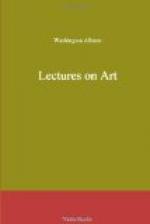As we have already seen that the Beautiful is limited to no particular form, but possesses its power in some mysterious condition, which is applicable to many distinct objects; in like manner does the Sublime include within its sphere, and subdue to its condition, an indefinite variety of objects, with their distinctive conditions; and among them we find that of the Beautiful, as well as, to a certain degree, its reverse, so that, though we may truly recognize their coexistence in the same object, it is not possible that their effect upon us should be otherwise than unequal, and that the higher law should not subordinate the lower. We do not deny that the Beautiful may, so to speak, mitigate the awful intensity of the Sublime; but it cannot change its character, much less impart its own; the one will still be awful, the other, of itself, never.
When at Rome, we once asked a foreigner, who seemed to be talking somewhat vaguely on the subject, what he understood by the Sublime. His answer was, “Le plus beau”; making it only a matter of degree. Now let us only imagine (if we can) a beautiful earthquake, or a beautiful hurricane. And yet the foreigner is not alone in this. D’Azzara, the biographer of Mengs, speaking of Beauty, talks of “this sublime quality,” and in another place, for certain reasons assigned, he says, “The grand style is beautiful.” Nay, many writers, otherwise of high authority, seem to have taken the same view; while others who could have had no such notion, having used the words Beauty and the Beautiful in an allegorical or metaphorical sense, have sometimes been misinterpreted literally. Hence Winckelmann reproaches Michael Angelo for his continual talk about Beauty, when he showed nothing of it in his works. But it is very evident that the Bella and Bellezza of Michael Angelo were never used by him in a literal sense, nor intended to be so understood by others: he adopted the terms solely to express abstract Perfection, which he allegorized as the mistress of his mind, to whose exclusive worship his whole life was devoted. Whether it was the most appropriate term he could have chosen, we shall not inquire. It is certain, however, that the literal adoption of it by subsequent writers has been the cause of much confusion, as well as vagueness.
For ourselves, we are quite at a loss to imagine how a notion so obviously groundless has ever had a single supporter; for, if a distinct effect implies a distinct cause, we do not see why distinct terms should not be employed to express the difference, or how the legitimate term for one can in any way be applied to signify a particular degree of the other. Like the two Dromios, they sometimes require a conjurer to tell which is which. If only Perfection, which is a generic term implying the summit of all things, be meant, there is surely nothing to be gained (if we except intended obscurity) by substituting a specific term which is limited to a few. We speak not here of allegorical or metaphorical propriety, which is not now the question, but of the literal and didactic; and we may add, that we have never known but one result from this arbitrary union,—which is, to procreate words.




